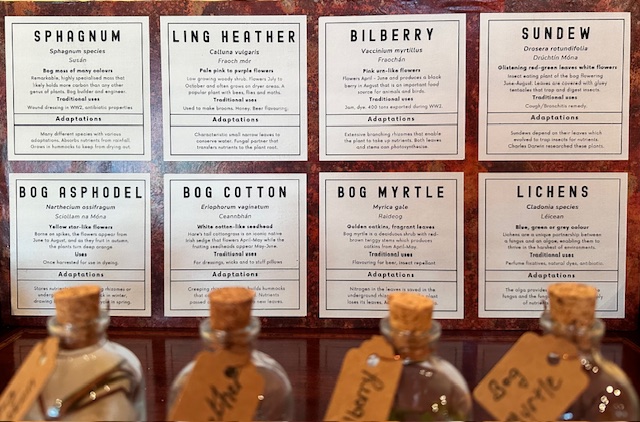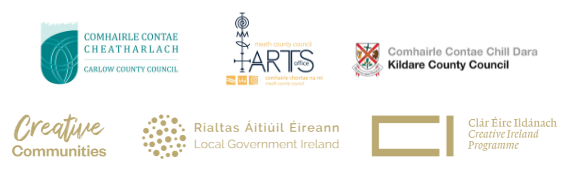The Bog Cabinet of Curiosities contains a collection of natural and culturally-derived objects that aim to prompt discovery and learning about the botanical wonders of the bog. It is on display from 25th June to the end of July in Lynch’s Pharmacy, Kells, Co. Meath as part of the Kells Type Trail.
In keeping with the Kells Type Trail tradition of translating a word every year into a variety of languages, this entry spells out the word “Evolve” in the language of bog plants. These diminutive plants have evolved over thousands of years, developing a variety of different strategies for growth and survival. They are heroes of the plant world in terms of carbon storage and continued resilience in our warming world. As Michael Pollan notes, “Plants are nature’s alchemist, expert at transforming water, soil and sunlight into an array of precious substances, many of them beyond the ability of human beings to conceive, much less manufacture” (The Botany of Desire).
The Bog Cabinet contains fragments of dried bog plants like the herbaria and pharmacies of old. An associated plant label provides the Common, Latin and Irish name for the bog plant in question. Knowing a plant’s name is not essential to appreciate it, but it is also a gesture of respect to know names. As Robin Wall Kimmerer writes: “Language is our gift and our responsibility. Words to remember old stories, to tell new ones, stories that bring science and spirit back together” (From her highly recommended book, Braiding Sweetgrass). The labels also provide information on flowers and flowering time, traditional uses of the past, and specific adaptations of the plant to the bog environment.
Other objects of curiosity include a buzzard feather, a wood pigeon skull (donated by Timothy Sullivan), a bottle found on the bog, ladybird nature books and other old naturalist books, a miniature besom made from heather, a picture of my mother on the bog near Ballaghadereen in the 1960’s and a short newspaper article about the collection of Sphagnum mosses during the war by the Kells Hospital and Work Supply Depot (Meath Chronicle, 1939).
In this Age of Mass Extinction, the fragments of plants in this cabinet – dried out, bottled and devoid of life – are a pale imitation of the experience of being in the landscape of a bog and observing the web of life in situ. Yet, as with all cultural artefacts, they may incite our curiosity to explore, to learn more, and perhaps bring us to visit these ancient landscapes. Girley Bog is a local bog where you can walk around the boardwalks to come up close and personal with these sensitive bog plants without damaging them. If you’d like to experience the benefits of this landscape, try out some of these “Bog Prescriptions” next time you visit.
The Bog Cabinet is a work in progress, unfolding with every outing as people respond to the objects in it with their own stories, memories and creativity (See examples of ‘Postcards’ created by people at the Textures, Tastes and Colours event displayed in the window). Please take a moment to view the cabinet, to think about the histories and futures of the objects in it, and what they remind you of.
The Bog Cabinet was developed as part of a collaborative arts project, Gnáthóga Nádúrtha / Natural Habitats, which is funded and supported with thanks to Creative Ireland (Carlow) and Carlow, Meath and Kildare County Council Arts Services. Artists Jules Michael, Monica de Bath and Kate Flood collaborated to unearth a physical expression of their work with the project and their local peatland (a Butter Firkin, a Bog Cabinet of Curiosities and a replica Ganger’s Hut). These objects converse with each other and provide a means to engage and tell stories about the places and the peatlands inspiring them. The project included a place-based mapping of each bog and their communities led by Dr. Anita McKeown and ecoliteracy training led by Dr. Cathy Fitzgerald.
Plant survival strategies – the challenges of life on the bog
Bog plants are expertly adapted to the tough conditions of life on the bog, conditions which most plants would not tolerate. Bogs are typically wet, often acidic and poor in nutrients, and exposed to wind and sun. The adaptations of bog plants enable them to survive the waterlogged conditions of the bog where there is little oxygen in the peat soil. Bog plants evolved to have spaces in their roots and stems to transport oxygen below ground (aerenchyma). They also conserve nutrients by having long-lived, evergreen leaves that can photosynthesise year round. Another special adaptation to low nutrient availability is an insect-eating plant called the Sundew. It obtains minerals from prey trapped via their modified leaves which have hairs and a sticky substance that attracts the insects. Sphagnum mosses are particularly adapted to bog conditions and in fact contribute to them. They are often called ‘Bog Engineers’, making their surroundings acidic and wet, slowing down decay so the bog builds up its store of carbon.
Cabinets of Curiosities
“What other justification for cabinets of curiosities than to conjure up images of the world, a miniature universe of textures, colours, materials, a multiplicty of forms? And in the end, they have succeeded in defying time”[1]
Appearing in Renaissance Europe, the ‘cabinet of curiosities’ is an ancestor of the modern museum. They played a fundamental role in the development of modern science, even if they weren’t always that ‘scientific’. The cabinets commonly featured antiques, objects of natural history (such as animals, dried insects, shells, skeletons, shells, herbarium, fossils) and works of art. They were a combination of magical caverns, apothecaries and laboratories, mixing old and new, science and superstition. Although they offered an opportunity to learn and wonder, these cabinets also symbolised the plundering of the natural world so prevalent in past (and unfortunately still in present) times. The objects in these cabinets were physical representations of knowledge and provide us with insights into attitudes of people at that time to nature, which was there to be collected, pinned, displayed, and objectified.
This propensity peaked in the 19th century when the Victorian interest in natural history combined with crazes for collecting rare and beautiful animals, plants and objects. It was common to collect and display rare plant and animal species including butterflies pinned under glass, taxidermy of all kinds of animals, bird eggshells, and a fern collecting craze known as ‘Pteridomania’, which led to significant reductions in wild populations of some rarer species, including Ireland’s Killarney Fern.
Yet despite their undoubted impact on the natural world, these collections have also left a legacy of knowledge. Museums around the world are filled with such collections, including the Museum of Natural History or “Dead Zoo” in Dublin. It houses 10,000 specimens at a time, while having some 2 million in storage, a million of which are insects.
I would like to think we had progressed from those days of viewing nature as only there for us to use as we like. Are we moving to a deeper understanding that we are nature, and everything we do affects us just as much as it impacts on the natural world? I fear, like Robin Wall Kimmerer, that “instead of sowing richness, we diminish the possibilities for the future at every turn“. Yet “the moral covenant of reciprocity calls us to honour our responsibilities for all we have been given, for all that we have taken. Whatever our gift, we are called to give it and to dance for the renewal of the world, on behalf of the earth” (Braiding Sweetgrass). It is our turn now to give back.
[1] Cabinets of Curiosities by Patrick Mauries








👏🏽👏🏽👏🏽
From: A Bog’s Life comment-reply@wordpress.com Sent: Monday, June 24, 2024 6:16 PM To: florence.renou@ucd.ie Subject: Bog Cabinet of Curiosities
The Bog Cabinet of Curiosities contains a collection of natural and culturally-derived objects that aim to prompt discovery and learning about the botanical wonders of the bog. It is on display from 25th June to the end of July in Lynch’s Pharmacy, Kell…
Read on blog https://abogslife.com/2024/06/24/bog-cabinet-of-curiosities/ or Reader https://public-api.wordpress.com/bar/?stat=groovemails-events&bin=wpcom_email_click&redirect_to=https%3A%2F%2Fwordpress.com%2Fread%2Fblogs%2F60519334%2Fposts%2F3597&sr=1&signature=b9bf896223118b6adb4741c97fb1f425&user=9135288dca526fb600f94489d10ebe7f&_e=eyJlcnJvciI6bnVsbCwiYmxvZ19pZCI6NjA1MTkzMzQsImJsb2dfbGFuZyI6ImVuIiwic2l0ZV9pZF9sYWJlbCI6IndwY29tIiwiaGFzX2ZlYXR1cmVkX2ltYWdlIjoiMCIsInN1YnNjcmliZXJfaWQiOiIxODA3MDg3NDEiLCJfdWkiOiI5MTM1Mjg4ZGNhNTI2ZmI2MDBmOTQ0ODlkMTBlYmU3ZiIsIl91dCI6ImFub24iLCJlbWFpbF9kb21haW4iOiJ1Y2QuaWUiLCJwb3N0X2lkIjozNTk3LCJ1c2VyX2VtYWlsIjoiZmxvcmVuY2UucmVub3VAdWNkLmllIiwiZGF0ZV9zZW50IjoiMjAyNC0wNi0yNCIsImVtYWlsX2lkIjoiNzAwYWFkMzlmOGJiYzMyOWFmOGFiZDRjZDg0OTA2YWIiLCJlbWFpbF9uYW1lIjoibmV3LXBvc3QiLCJ0ZW1wbGF0ZSI6Im5ldy1wb3N0IiwibGlua19kZXNjIjoicmVhZGVyLXVybCIsImFuY2hvcl90ZXh0IjoiUmVhZGVyIiwiX2RyIjpudWxsLCJfZGwiOiJcL3dwXC92Mlwvc2l0ZXNcLzYwNTE5MzM0XC9wb3N0c1wvMzU5Nz9fZW52ZWxvcGU9MSZlbnZpcm9ubWVudC1pZD1wcm9kdWN0aW9uJl9ndXRlbmJlcmdfbm9uY2U9YjY3NGRkNTNhOCZfbG9jYWxlPXVzZXIiLCJfZW4iOiJ3cGNvbV9lbWFpbF9jbGljayIsIl90cyI6MTcxOTI0OTM2MTM4NCwiYnJvd3Nlcl90eXBlIjoicGhwLWFnZW50IiwiX2F1YSI6IndwY29tLXRyYWNrcy1jbGllbnQtdjAuMyIsIl91bCI6bnVsbCwiYmxvZ190eiI6IjEiLCJ1c2VyX2xhbmciOm51bGx9&_z=z
[image: Site logo image]
A Bog’s Life http://abogslife.com
Read on blog https://abogslife.com/2024/06/24/bog-cabinet-of-curiosities/ or Reader https://public-api.wordpress.com/bar/?stat=groovemails-events&bin=wpcom_email_click&redirect_to=https%3A%2F%2Fwordpress.com%2Fread%2Fblogs%2F60519334%2Fposts%2F3597&sr=1&signature=b9bf896223118b6adb4741c97fb1f425&user=9135288dca526fb600f94489d10ebe7f&_e=eyJlcnJvciI6bnVsbCwiYmxvZ19pZCI6NjA1MTkzMzQsImJsb2dfbGFuZyI6ImVuIiwic2l0ZV9pZF9sYWJlbCI6IndwY29tIiwiaGFzX2ZlYXR1cmVkX2ltYWdlIjoiMCIsInN1YnNjcmliZXJfaWQiOiIxODA3MDg3NDEiLCJfdWkiOiI5MTM1Mjg4ZGNhNTI2ZmI2MDBmOTQ0ODlkMTBlYmU3ZiIsIl91dCI6ImFub24iLCJlbWFpbF9kb21haW4iOiJ1Y2QuaWUiLCJwb3N0X2lkIjozNTk3LCJ1c2VyX2VtYWlsIjoiZmxvcmVuY2UucmVub3VAdWNkLmllIiwiZGF0ZV9zZW50IjoiMjAyNC0wNi0yNCIsImVtYWlsX2lkIjoiNzAwYWFkMzlmOGJiYzMyOWFmOGFiZDRjZDg0OTA2YWIiLCJlbWFpbF9uYW1lIjoibmV3LXBvc3QiLCJ0ZW1wbGF0ZSI6Im5ldy1wb3N0IiwibGlua19kZXNjIjoicmVhZGVyLXVybCIsImFuY2hvcl90ZXh0IjoiUmVhZGVyIiwiX2RyIjpudWxsLCJfZGwiOiJcL3dwXC92Mlwvc2l0ZXNcLzYwNTE5MzM0XC9wb3N0c1wvMzU5Nz9fZW52ZWxvcGU9MSZlbnZpcm9ubWVudC1pZD1wcm9kdWN0aW9uJl9ndXRlbmJlcmdfbm9uY2U9YjY3NGRkNTNhOCZfbG9jYWxlPXVzZXIiLCJfZW4iOiJ3cGNvbV9lbWFpbF9jbGljayIsIl90cyI6MTcxOTI0OTM2MTM4NSwiYnJvd3Nlcl90eXBlIjoicGhwLWFnZW50IiwiX2F1YSI6IndwY29tLXRyYWNrcy1jbGllbnQtdjAuMyIsIl91bCI6bnVsbCwiYmxvZ190eiI6IjEiLCJ1c2VyX2xhbmciOm51bGx9&_z=z Bog Cabinet of Curiosities https://public-api.wordpress.com/bar/?stat=groovemails-events&bin=wpcom_email_click&redirect_to=http%3A%2F%2Fabogslife.com%2F2024%2F06%2F24%2Fbog-cabinet-of-curiosities%2F&sr=0&signature=89d7b4848cd6cac884cd038ffe3fb062&blog_id=60519334&user=9135288dca526fb600f94489d10ebe7f&_e=eyJlcnJvciI6bnVsbCwiYmxvZ19pZCI6NjA1MTkzMzQsImJsb2dfbGFuZyI6ImVuIiwic2l0ZV9pZF9sYWJlbCI6IndwY29tIiwiaGFzX2ZlYXR1cmVkX2ltYWdlIjoiMCIsInN1YnNjcmliZXJfaWQiOiIxODA3MDg3NDEiLCJfdWkiOiI5MTM1Mjg4ZGNhNTI2ZmI2MDBmOTQ0ODlkMTBlYmU3ZiIsIl91dCI6ImFub24iLCJlbWFpbF9kb21haW4iOiJ1Y2QuaWUiLCJwb3N0X2lkIjozNTk3LCJ1c2VyX2VtYWlsIjoiZmxvcmVuY2UucmVub3VAdWNkLmllIiwiZGF0ZV9zZW50IjoiMjAyNC0wNi0yNCIsImVtYWlsX2lkIjoiNzAwYWFkMzlmOGJiYzMyOWFmOGFiZDRjZDg0OTA2YWIiLCJlbWFpbF9uYW1lIjoibmV3LXBvc3QiLCJ0ZW1wbGF0ZSI6Im5ldy1wb3N0IiwibGlua19kZXNjIjoicG9zdC11cmwiLCJhbmNob3JfdGV4dCI6IkJvZyBDYWJpbmV0IG9mXHUwMGEwQ3VyaW9zaXRpZXMiLCJfZHIiOm51bGwsIl9kbCI6Ilwvd3BcL3YyXC9zaXRlc1wvNjA1MTkzMzRcL3Bvc3RzXC8zNTk3P19lbnZlbG9wZT0xJmVudmlyb25tZW50LWlkPXByb2R1Y3Rpb24mX2d1dGVuYmVyZ19ub25jZT1iNjc0ZGQ1M2E4Jl9sb2NhbGU9dXNlciIsIl9lbiI6IndwY29tX2VtYWlsX2NsaWNrIiwiX3RzIjoxNzE5MjQ5MzYxMzg1LCJicm93c2VyX3R5cGUiOiJwaHAtYWdlbnQiLCJfYXVhIjoid3Bjb20tdHJhY2tzLWNsaWVudC12MC4zIiwiX3VsIjpudWxsLCJibG9nX3R6IjoiMSIsInVzZXJfbGFuZyI6bnVsbH0&_z=z
By abogslife on June 24, 2024
The Bog Cabinet of Curiosities contains a collection of natural and culturally-derived objects that aim to prompt discovery and learning about the botanical wonders of the bog. It is on display from 25th June to the end of July in Lynch’s Pharmacy https://abogslife.wordpress.com?action=user_content_redirect&uuid=c8b25b9f2a78814645a5a1fe435e93a4f0f9e44031989a5e0110edbb7406d3de&blog_id=60519334&post_id=3597&user_id=0&subs_id=180708741&signature=ef8d1e4aec38eba8bca551668ef94f94&email_name=new-post&user_email=florence.renou@ucd.ie&encoded_url=aHR0cHM6Ly93d3cuaW5zdGFncmFtLmNvbS9seW5jaHN0b3RhbGhlYWx0aHBoYXJtYWN5a2VsbHM/dXRtX3NvdXJjZT1pZ193ZWJfYnV0dG9uX3NoYXJlX3NoZWV0Jmlnc2g9WkRObFpEYzBNekl4Tnc9PQ=, Kells, Co. Meath as part of the Kells Type Trail https://abogslife.wordpress.com?action=user_content_redirect&uuid=9adbda543dac4bb70f9c318be05bfefe216fbc352e1a66308635da8327e5a5b8&blog_id=60519334&post_id=3597&user_id=0&subs_id=180708741&signature=8d68c051865c4c3ec85e44eba45bebd7&email_name=new-post&user_email=florence.renou@ucd.ie&encoded_url=aHR0cDovL3d3dy5rZWxsc3R5cGV0cmFpbC5jb20v.
As Michael Pollan notes, “Plants are nature’s alchemist, expert at transforming water, soil and sunlight into an array of precious substances, many of them beyond the ability of human beings to conceive, much less manufacture” (The Botany of Desire). In keeping with the Kells Type Trail https://abogslife.wordpress.com?action=user_content_redirect&uuid=9adbda543dac4bb70f9c318be05bfefe216fbc352e1a66308635da8327e5a5b8&blog_id=60519334&post_id=3597&user_id=0&subs_id=180708741&signature=8d68c051865c4c3ec85e44eba45bebd7&email_name=new-post&user_email=florence.renou@ucd.ie&encoded_url=aHR0cDovL3d3dy5rZWxsc3R5cGV0cmFpbC5jb20v tradition of translating a word every year into a variety of languages, this entry spells out the word “Evolve” in the language of bog plants. These diminuitive plants have evolved over 1000’s of years, developing a variety of different strategies for growth and survival. They are heroes of the plant world in terms of carbon storage and continued resilience in our warming world.
https://abogslife.wordpress.com/?action=user_content_redirect&uuid=ba8d4299fd8fa10403d0ef4459be2451865bc4ac78aaedcad1f24906ac426d75&blog_id=60519334&post_id=3597&user_id=0&subs_id=180708741&signature=869affe3ceac1af8dd12d6d1dd0e4b8b&email_name=new-post&user_email=florence.renou@ucd.ie&encoded_url=aHR0cHM6Ly9hYm9nc2xpZmUuY29tL3dwLWNvbnRlbnQvdXBsb2Fkcy8yMDI0LzA2L2JvdHRsZXMuanBn
The Bog Cabinet contains fragments of dried bog plants like the herbaria and pharmacies of old, and an associated plant label containing the Common, Latin and Irish name for the bog plant in question. Knowing a plant’s name is not essential to appreciate it, but it is also a gesture of respect to know names. As Rob